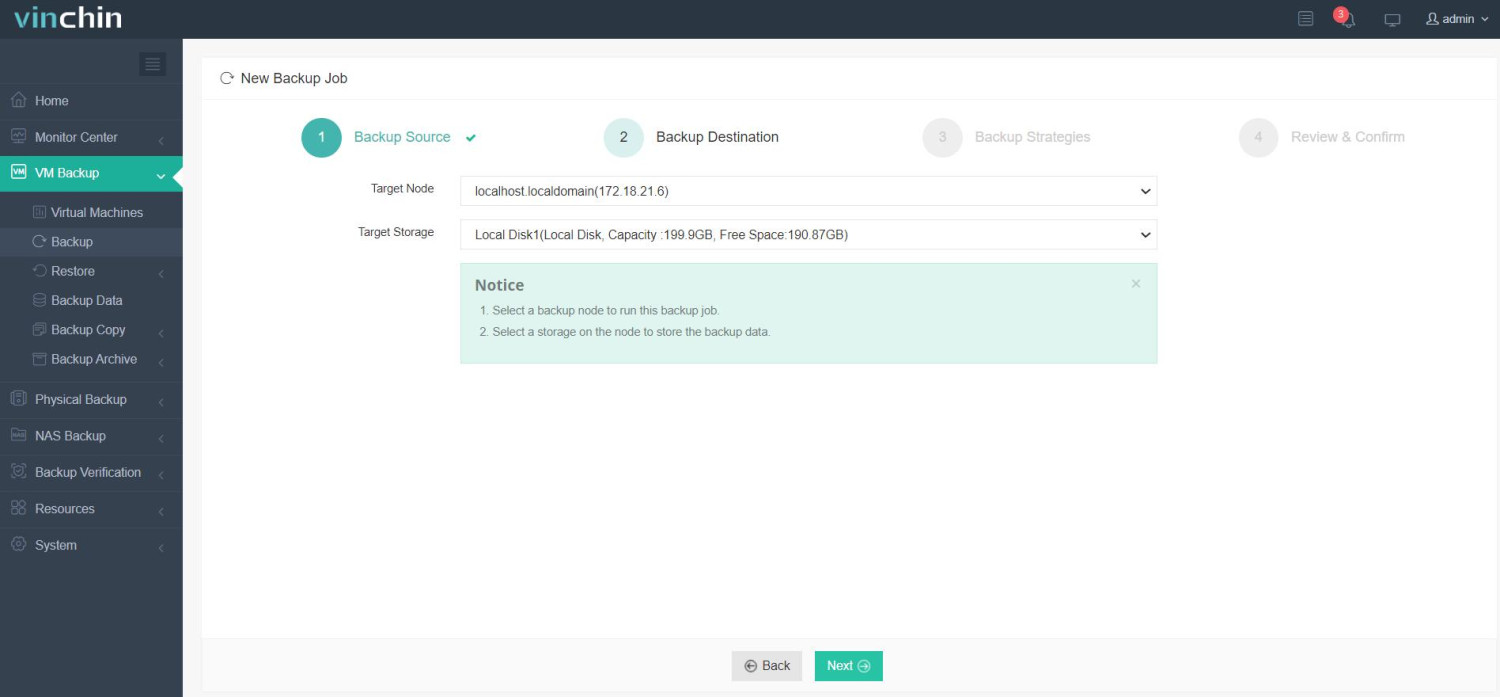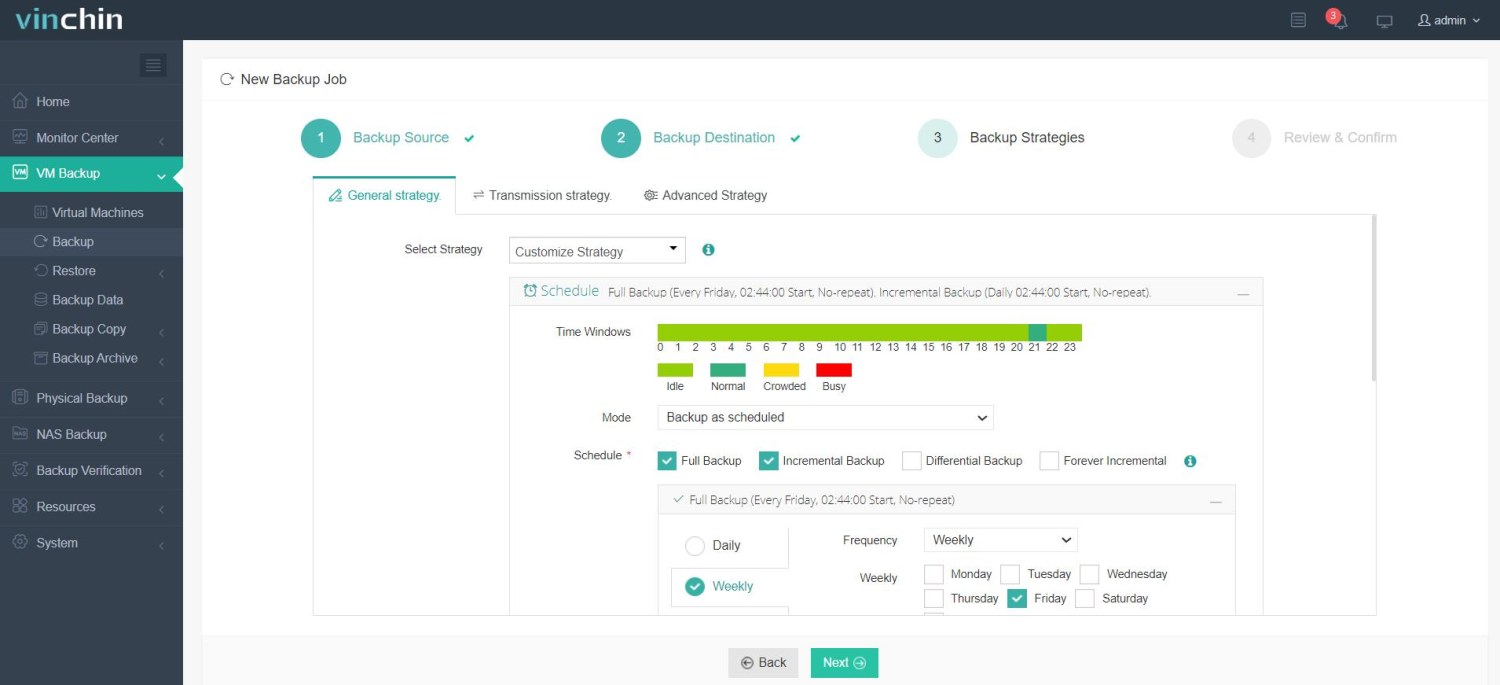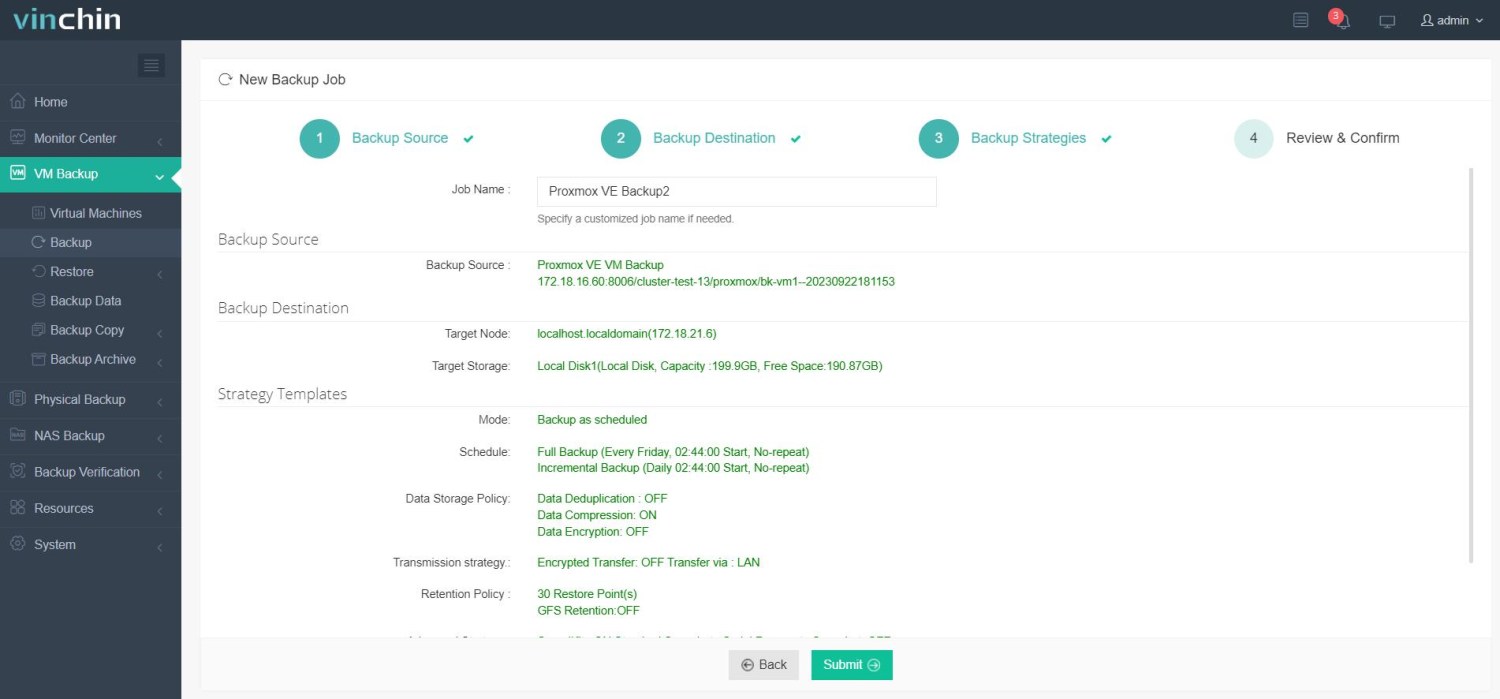-
What is the Proxmox backup?
-
Why Proxmox backup slow?
-
How to fix slow Proxmox backups?
-
Speed up Proxmox backups with Vinchin
-
Proxmox backup very slow FAQs
-
Conclusion
What is the Proxmox backup?
Proxmox VE is an open-source platform that lets you manage virtual machines and containers. To protect data, it includes a backup feature. You can use its built-in tool, vzdump, or pair it with Proxmox Backup Server (PBS).
vzdump creates backups of VM or CT disks and configuration files. It can save them locally or to remote storage. It supports snapshot, suspend, and stop modes. Most users choose snapshot for online backups.
PBS is an external solution optimized for Proxmox backups. It offers features like deduplication, encryption, compression, and fast restore. It connects to Proxmox through Proxmox VE API or scheduled jobs.
Backup speed depends on disk I/O, network bandwidth, file system, compression, and CPU load. If backups run slowly, one or more of these may be the cause.
Why Proxmox backup slow?
Slow backups are frustrating. They waste time and delay operations. Let's look at why they happen.
1. Storage Performance Bottlenecks
If your backup target has slow disks (e.g., 5400 RPM HDDs or busy shared storage), backup speed will drop. IOPS limits, latency, and write throughput matter.
When using ZFS, settings like recordsize and sync impact performance. Misconfigured volumes or fragmented disks also slow down the backup process.
2. Network Bandwidth and Latency
Backups over the network can become bottlenecked by 1GbE links, busy switches, or poor NIC configuration. If the link between your Proxmox node and backup storage is slow, so are your backups.
3. VM Workload During Backup
If VMs write heavily to disk during the backup, snapshot-based tools need to read changed blocks before writing them to backup storage. This can stall writes until reading completes.
4. Too Many Concurrent Jobs
Running multiple backup jobs at once can overload your storage, CPU, or RAM. If all jobs compress, encrypt, and write at once, they compete for resources.
5. Inefficient Compression or Encryption
Using CPU-heavy compression (like zstd at high levels) or software-only encryption can bog down your node. If AES-NI isn't available, encryption becomes expensive.
6. Proxmox Configuration Limits
Default settings in /etc/vzdump.conf may not suit larger systems. You may need to increase max_workers or tweak other parameters. Backup jobs may run with default priority, causing competition with active VM processes.
7. Backup Mode Selection
Using --mode stop or --mode suspend causes VM downtime. But even --mode snapshot can be slow if your storage doesn't support fast snapshots or if your VM has lots of changed data.
8. Backup Target Type
Backups to NFS can be slower than to iSCSI or local ZFS, depending on tuning. NFS shares may suffer from locking delays, slow metadata operations, or network retransmissions.
How to fix slow Proxmox backups?
Speeding up Proxmox backups starts with knowing where the delay comes from. Let's fix it step by step.
Check Disk and I/O Performance
Backups write a lot of data. You must know if your disks can handle the load.
Use tools like:
iostat -x 1
Check for high await or %util values. If your disk is near 100% utilization, consider faster storage.
On ZFS, optimize:
recordsize=1M for large sequential writes
sync=disabled (only for non-critical backups)
Limit deduplication unless you know it helps
Monitor ARC cache usage using:
arcstat 1
ZFS over HDDs will always be slower than SSDs or NVMe. Consider adding a fast SLOG or L2ARC device.
Optimize Network Throughput
For network backups, test bandwidth between Proxmox and PBS using:
iperf3 -c <PBS_IP>
If you see low speeds, fix the network. Upgrade to 10GbE if possible. If you're already on 10GbE, verify jumbo frames:
ip link set dev eth0 mtu 9000
Use ethtool to check NIC settings:
ethtool -K eth0 gro on gso on tso on
Enable TCP window scaling:
sysctl -w net.ipv4.tcp_window_scaling=1
For bonded links, use mode=802.3ad and match switch settings.
Reduce Compression and Encryption Overhead
Compression is useful but can slow you down. Test with:
zstd -1 vs. zstd -6
Use lower levels or disable it to see if speed improves.
Make sure AES-NI is enabled for encryption. If your CPU lacks it, expect slowness.
In PBS, set encryption at rest rather than during transmission to avoid real-time CPU load.
Stagger Backup Jobs
Edit /etc/vzdump.conf:
max_workers: 2 ionice: 7 nice: 20
This limits job concurrency and reduces CPU and I/O impact.
In Proxmox GUI, schedule backups at different times per node or VM group. Avoid peak business hours.
Tune vzdump and Job Options
Run backups using snapshot mode:
vzdump 101 --mode snapshot --compress zstd --storage backup-pool
Avoid stop or suspend unless needed. Use --bwlimit to prevent I/O spikes.
Use Fast and Local Backup Targets
If possible, back up to local storage or SSD/NVMe targets. Avoid slow NFS or shared spinning disks.
If using NFS:
Enable NFS v4
Mount with options: rw,async,noatime,nodiratime
Avoid soft mounts that retry slowly on failure
Monitor Logs and Metrics
Parse vzdump logs. Look for lines like:
duration: 00:35:14, backup-job: delay: 00:14:23
"Delay" shows I/O wait. Use this to spot bottlenecks.
Use Proxmox graphs or external tools (Grafana, Zabbix) to monitor disk IOPS, CPU usage, and network throughput.
Prioritize Backup Processes
Use these commands to reduce backup priority:
ionice -c3 -p $(pgrep vzdump) nice -n 20 -p $(pgrep vzdump)
This lowers backup load and gives active VMs more resources.
Plan for Enterprise Setups
If you run a cluster, don't back up all nodes at once. Use a backup server with a dedicated NIC.
For Ceph users, beware: backups stress OSDs. Consider offloading backups to PBS with SSD/NVMe storage and ZFS tuning.
For hyperconverged setups, test during off-peak hours. Backups compete with VM traffic.
Solve Common Errors
"Failed to lock VM": A backup or snapshot job is already running. Wait or unlock manually:
qm unlock 101
NFS timeouts: Increase mount timeout, check server logs.
PBS authentication errors: Re-add PBS target in Datacenter > Storage.
Keep Proxmox Updated
Each release improves vzdump and backup routines. Stay current with:
apt update && apt dist-upgrade
Check Proxmox and PBS changelogs for backup-related fixes or enhancements.
Speed up Proxmox backups with Vinchin
If Proxmox backups are still slow or limited, try Vinchin Backup & Recovery—a professional, enterprise-level solution built with native support for Proxmox VE. It provides reliable performance, wide VM compatibility, and centralized management to simplify backup across your environment.
Vinchin accelerates protection with forever-incremental backups, built-in deduplication and compression, and advanced features like V2V migration, CBT, and instant recovery. With its clean, web-based console, Proxmox VM backups become faster, lighter, and easier to manage.
Backing up a Proxmox VM with Vinchin takes only four simple steps:
1.Just select VMs on the host

2.Then select backup destination

3.Select strategies

4.Finally submit the job

Trusted by organizations across the globe, Vinchin has earned high praise for performance, ease of use, and strong support. You can explore all features free for 60 days. Click below to download the installer and deploy in minutes.
Proxmox backup very slow FAQs
Q1: How do I test if slow backup speed is due to the network?
Use iperf3 between Proxmox and your backup target to measure bandwidth.
Q2: Why is my PBS backup stuck at 0%?
Check for ZFS pool issues, slow target disk, or snapshot problems on the source VM.
Q3: How do I throttle Proxmox backup speed?
Add --bwlimit <MBps> to your vzdump command to limit bandwidth.
Conclusion
Slow Proxmox backups can come from storage limits, network issues, or misconfiguration. By tuning your setup and following best practices, you can speed things up. But if problems remain, Vinchin Backup & Recovery offers a faster, simpler way to protect Proxmox VMs—reliable, efficient, and built for scale.
Share on:






